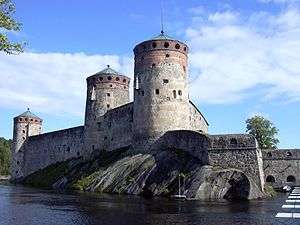Olavinlinna

Olavinlinna (Swedish: Olofsborg; literally Olaf's Castle, see Olaf II of Norway) is a 15th-century three-tower castle located in Savonlinna, Finland. It is the northernmost medieval stone fortress still standing.[1]
The castle is built on an island in the Kyrönsalmi strait that connects the lakes Haukivesi and Pihlajavesi.
Construction
The fortress was founded by Erik Axelsson Tott in 1475 under the name Sankt Olofsborg in an effort to profit from the political turmoil following Ivan III's conquest of the Novgorod Republic. It was sited in Savonia so as to lay claim to the Russian side of the border established by the Treaty of Nöteborg.

One of Tott's letters from 1477 includes a passing mention of foreign builders invited to Olofsborg, probably from Reval, where the city fortifications were being extended. It was the first Swedish castle provided with a set of thickset circular towers that could withstand cannon fire. It is not by accident that a network of lakes and waterways forms the setting for the castle, for these would seriously impede a prospective Russian offensive.
The three-towered keep was completed 1485, and the construction of the outer curtain walls with two towers was initiated immediately. They were completed 1495. The castle is roughly a truncated rhomboid with keep on the western side of the island and the curtain walls and outer bailey to east. One of the towers of the keep, St. Erik's Tower, has bad foundation and has since collapsed. One of the towers of bailey, the Thick Tower, exploded in the 18th century. A bastion has been built on its place. The castle was converted into a Vaubanesque fort in the late 19th century with bastions.

- Keep
- Outer Bailey
- Bell Tower (St. Virgin's Tower)
- Church Tower (St. Olof's Tower)
- Kijl's Tower
- Thick Bastion (on place of Thick Tower)
- Ruins of the collapsed St Erik's Tower)
- Bell Bastion (semi-bastion)
- Gateway Curtain
- Watergate Curtain
- Curtain wall
- Smallgate Bastion
- Suvorov's Bailey
History
Olofsborg withstood several sieges by the Russians during the First and Second Russian-Swedish wars. A brisk trade developed under the umbrella of the castle towards the end of the 16th century, giving birth to the town of Savonlinna, which was chartered in 1639.
On 28 July 1714, the garrison capitulated to the invading Russians, and it took them only two days to take the castle in 1743, in the events leading up to the Treaty of Åbo which awarded the entire region to Empress Elizabeth of Russia.
Tourism
The castle hosts several small exhibitions, including the Castle Museum which displays artifacts found in the castle or related to it, and the Orthodox Museum which displays icons and other religious artifacts both from Finland and Russia. The castle forms a spectacular stage for the Savonlinna Opera Festival, held annually in the summer since 1912.
Olavinlinna is the initial model for Kropow Castle in the comic book King Ottokar's Sceptre, an album in the series of Adventures of Tintin created by Hergé.[2]
References
- ↑ Archived December 25, 2008, at the Wayback Machine.
- ↑ Severi Nygård: Tintti Suomessa. Helsingin Sanomat, Kuukausiliite, october 2008.
External links
| Wikimedia Commons has media related to: |
- St. Olaf's Castle at the Finnish National Board of Antiquities
- Savonlinna Opera Festival – Official website
- Medieval castles in Finland
Coordinates: 61°51′50″N 028°54′04″E / 61.86389°N 28.90111°E